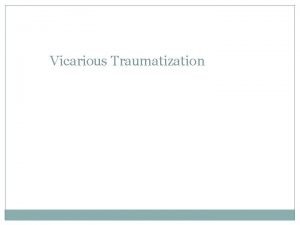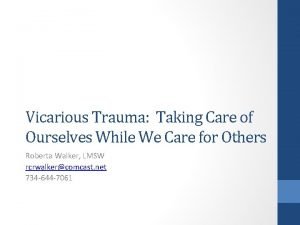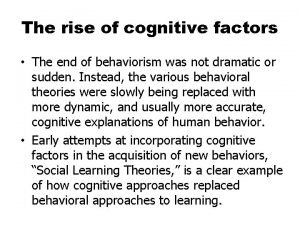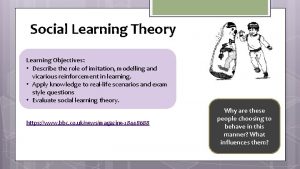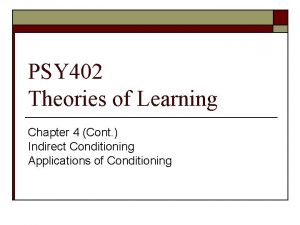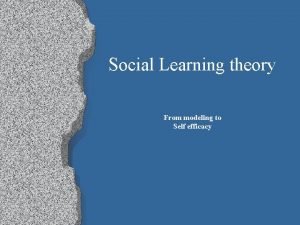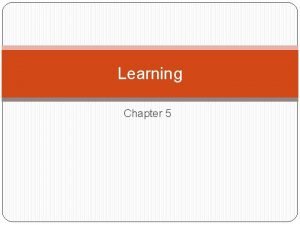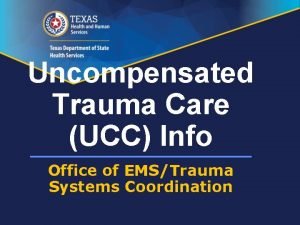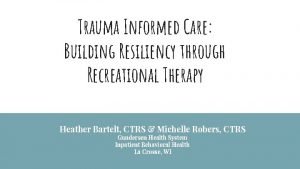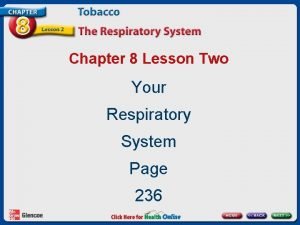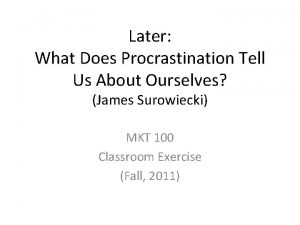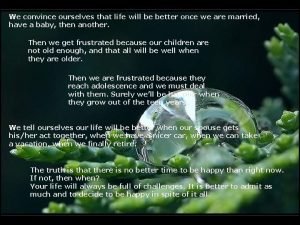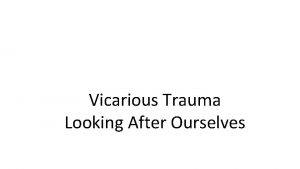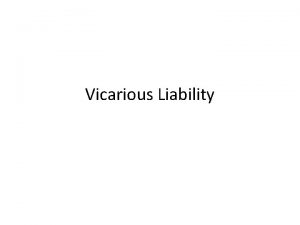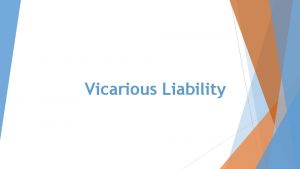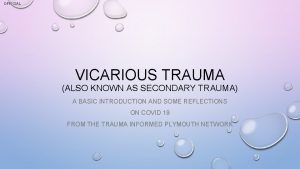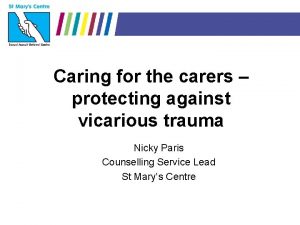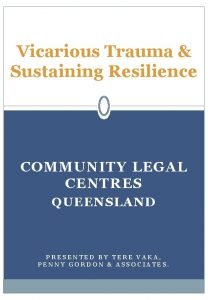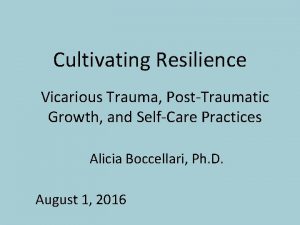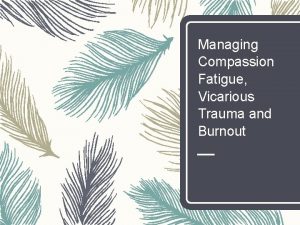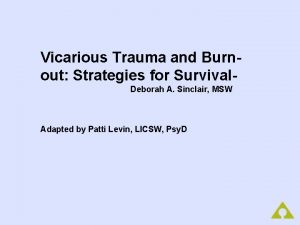Vicarious Trauma Taking Care of Ourselves While We


































- Slides: 34

Vicarious Trauma: Taking Care of Ourselves While We Care for Others Roberta Walker, LMSW rcrwalker@comcast. net 734 -644 -7061

Activity Take an index card, and without talking with others, please write down one of these on each side of your index cards: • Three most important people in your life (can be more than three but at least three) • Three life challenges that you have overcome or are currently facing • Three most important places in your life

“Be kind, for everyone you meet is fighting a hard battle. ”

Defining Trauma “Individual trauma results from an event, series of events, or set of circumstances experienced by an individual as physically or emotionally harmful or life-threatening with lasting adverse effects on the individual’s functioning and mental, physical, social, emotional, or spiritual well-being. ” (SAMHSA, 2019) “Traumatic events are extraordinary, not because they occur rarely, but rather because they overwhelm the ordinary human adaptations to life. ” (Herman, 1997)

Physical Reactions to Trauma • A state of hyperarousal: FIGHT, FLIGHT, FREEZE • Hormones, such as adrenaline, are released into the body • In FIGHT, we become energized to overcome a perceived danger • In FLIGHT, we realize that we can not overcome the danger and so we use our biochemical processes to run • In FREEZE, we realize (often quickly) that we can neither fight or flee, so our brains and bodies “dissociate” or “numb out”

Vicarious Trauma is the process of change that happens because you care about other people who have been hurt, and feel committed or responsible to help them. “The expectation that we can be immersed in suffering and loss daily and not be touched by it is as unrealistic as expecting to be able to walk through water without getting wet. ” (Remen 2006).

Vicarious Trauma is a Process • Vicarious trauma unfolds over time. It is the cumulative effect of contact with people who are struggling. • This process of change is ongoing and influenced by your life experiences. • There are many opportunities along the way to recognize the impact your work is having on you and to think about how to protect and care for yourself while doing that work.

Symptoms of Vicarious Trauma • Symptoms parallel those of PTSD, including anxiety, despair, intrusive imagery, sleep disruption, cynicism, hostility, difficulty maintaining helping relationships. • Thought processes include “this situation is hopeless” “the clients bring it on themselves” and “there’s nothing anyone can do to help. ”

Differences Between Vicarious Trauma and “Burnout” • Burnout is a feeling of exhaustion and lack of motivation. • Vicarious trauma can overlap with stress and burnout, but it has specific symptoms parallel to PTSD. • Burnout can often be alleviated by time off, encouragement, professional training or motivational workshops. • Vicarious trauma requires more intensive efforts to target it specifically.

• What are some ways that you have changed over time as a result of your work? • How does your sense of commitment and responsibility to your work help you? • Are there ways in which your sense of commitment and responsibility to your work might hurt you? How?

Unrecognized Vicarious Trauma Impacts Individual Work • Over-identification with those you serve. The staff become overwhelmed and come to identify themselves as helpless victims. • Trouble maintaining professional boundaries.

Unrecognized Vicarious Trauma Impacts Individual Work • Experiencing typical organizational frictions as persecution. • Development of cynicism and hostility toward persons served and the organization. • Compassion fatigue, or believing that the bad things that happen to persons served are their fault. This leads to difficulty engaging with those we serve and developing a hopeful rapport.

Increased Risks for Vicarious Trauma • Vicarious Trauma affects everyone, but some are at higher risk: • Newer persons in the field who are still developing their own coping strategies. • During periods of personal stress, such as divorce, illness. • When a helper identifies personally with the experience of the person served or has similar sociocultural backgrounds.

Increased Risks for Vicarious Trauma • Lack of social support • Disconnection from spirituality • Having unsustainable work styles • Unrealistic expectations • Working long hours without breaks • Not using supervision effectively

How Unrecognized Vicarious Trauma Impacts Organizations • When several staff members suffer vicarious trauma, there is a risk of it becoming institutionalized. • Senior staff may communicate hopelessness or despair, blame those we serve, creating a culture that reinforces vicarious trauma.

The Impact of Unmitigated Vicarious Trauma on Organizations • Absenteeism • High staff turnover • Pervasive negativity in meetings and collegial communications • Low staff morale • Grievances filed by staff and persons served • Low attendance and retention rates

Organizational Strategies • Create a culture of compassion. Policies and procedures must include the cultural values of compassion. • Include all staff in understanding and supporting a compassionate culture, not just direct service providers. • Create an atmosphere that says “We are all in this together. ”

Organizational Strategies • Compassion, respect for others, and shared commitment to working with underserved populations must be included in job postings, interviewing, hiring decisions and onboarding. • Interviewing should include questions regarding the applicant’s ability to cope with stress and experience in working with traumatized populations.

Organizational Strategies • Staff members are provided options, when possible, regarding factors that affect their daily work • Hours – flex time, timing of leave • Office décor • Trainings offered

Supervisory Strategies • Reflective and supportive supervision: • How the supervisee feels about their work • Professional development • Assessment of vicarious trauma • Balance between supporting staff in self care but not giving the message that the work is impossible. The work must stay client centered. • Staff should be encouraged to take regular lunch breaks, use vacation leave and take sick leave as needed.

Team Strategies • Create a culture and expectation that help seeking is a sign of strength, not weakness • Establish help seeking norms, such as discussing where help is available and post resources • Reduce stigma by leaving resources continuously, universally accessible and using examples • Recognize signs among colleagues of distress and engage where/when appropriate

Team Strategies • Build Self Care Strategies into Team Processes Provide resources that promote wellness Use regular relaxation and calming exercises Take walks or hold meetings outside Lead regular non-intrusive relaxation or intention setting exercises to promote self-regulation and mindfulness/awareness. • Have team members keep gratitude journals or journaling together as a team activity • Use artwork or other activities that create reflection, contemplation. Have an inspiration table that team members can voluntarily add to. • •

Team Strategies • Promote self care through self care groups • Have an assigned facilitator. Can be rotated among group members. • Activities and structure may include check in, readings, inspirational stories, feedback, self care activities. • Use workbooks for structured activities. • Supervisors might need their own self care group. • Review and evaluate regularly. Change as needed.

Team Strategies • Promote team morale with optimism and support. • Use staff meeting “book ends” that begin a meeting with a success and end with acknowledgements. • Practicing gratitude increases optimism, joy and positive emotions. • Have colleagues share inspirations such as quotations or events. Begin a meeting with “what touched you today? ” • Celebrate and acknowledge community partners that contribute to the learning community. • Have celebrations for occasions such as work anniversaries, funding awards, birthdays.

Individual Strategies: Be Cool, Monitor Your Heat Level

Journal Your Heat Level Monday 1 2 3 4 5 6 7 8 9 10 off the chart! Dark Light Green Yellow Orange Red Blue Tuesday 1 2 3 4 5 6 7 8 9 10 off the chart! Dark Light Green Yellow Orange Red Blue

Characteristics of Reactivity REACTIONS Body Tension/arousal Emotions Thoughts Speaking Style Facial Expressions Others HIGH LOW

Individual Strategies Learn about vicarious trauma and self care Use supervision to address vicarious trauma Be aware of and follow organizational safety procedures Maintain a healthy work life balance Develop and implement a plan for self care Use a buddy system to keep your plan on track Be aware of your own stress level and be proactive in addressing your needs • Use counseling when necessary • •

Individual Strategies: 10 Things to Do 1. 2. 3. 4. 5. 6. 7. 8. 9. 10. Get enough sleep. Get enough to eat. Do some light exercise. Vary the work that you do. Do something pleasurable. Focus on what you did well. Learn from your mistakes. Share a private joke. Pray, meditate or relax. Support a colleague.

Switching On and Off • Switching is a conscious process. Talk to yourself as you switch. • Use images that make you feel safe and protected (switch off) or connected, cared for (switch on) to help you switch. • Find rituals that help you switch as you start and stop work. • Breathe slowly and deeply to help yourself through a difficult task or job.

Vicarious Resilience describes the ways that we as helpers may develop strength, inspiration , and wisdom from witnessing the resilience of our clients.

Closing Activity Take a moment to review and honor the impact on you of having observed a client’s: -Recovery or perseverance after a tragedy or time of hopelessness - Resilience or resourcefulness in an overwhelming circumstance - Experience of unexpected human support or sacrifice - Faith or spiritual inspiration during a time of suffering

Compassion with Equanimity Meditation Everyone is on his or her own life journey. I am not the cause of this person's suffering, nor is it entirely within my power to make it go away, even though I wish I could. There are times when this relationship is difficult to bear, yet I may still try to help if I can. - Christopher Germer

References www. headington-institute. org On this website, you can find the manual “Understanding and Addressing Vicarious Trauma” by Dr. Laurie Ann Pearlman and Lisa Mc. Kay. www. proqol. org On this website, you can find measures and activities to promote positive professional quality of life. www. therapistrefresh. com This website is devoted to helping therapists with vicarious trauma. There are excellent meditations and exercises, and you can receive regular emails with ideas for promoting wellness.
 Robyn bradey vicarious trauma
Robyn bradey vicarious trauma Definition of vicarious trauma
Definition of vicarious trauma Vicarious traumatisation
Vicarious traumatisation The james lange theory of emotion states that
The james lange theory of emotion states that Primary secondary tertiary health care
Primary secondary tertiary health care Statement while... wend digunakan untuk
Statement while... wend digunakan untuk Vicariously sentence
Vicariously sentence Vicarious reinforcement
Vicarious reinforcement Yewen v noakes
Yewen v noakes Evaluate social learning theory
Evaluate social learning theory Vicarus fili dei
Vicarus fili dei Operant conditioning vs classical conditioning
Operant conditioning vs classical conditioning Vicarious reinforcement
Vicarious reinforcement Vicarious reinforcement
Vicarious reinforcement Vicarious transformation
Vicarious transformation Vicarious liability means
Vicarious liability means The law of effect
The law of effect Trauma-informed care activities for staff
Trauma-informed care activities for staff Pillars of trauma informed care
Pillars of trauma informed care Uncompensated trauma care application texas
Uncompensated trauma care application texas 4 r's trauma informed care
4 r's trauma informed care Trauma informed care for foster youth
Trauma informed care for foster youth 4 r's trauma informed care
4 r's trauma informed care Early total care
Early total care Lgbtq trauma informed care
Lgbtq trauma informed care Family enhancement center
Family enhancement center Trauma informed practice
Trauma informed practice 4 r's trauma informed care
4 r's trauma informed care Tina champagne trauma informed care
Tina champagne trauma informed care Taking care of your respiratory system
Taking care of your respiratory system What does procrastination tell us about ourselves
What does procrastination tell us about ourselves We convince ourselves that life will be better
We convince ourselves that life will be better Awareness of ourselves and our environment is
Awareness of ourselves and our environment is History helps us understand people and societies.
History helps us understand people and societies. Let's remind ourselves
Let's remind ourselves

